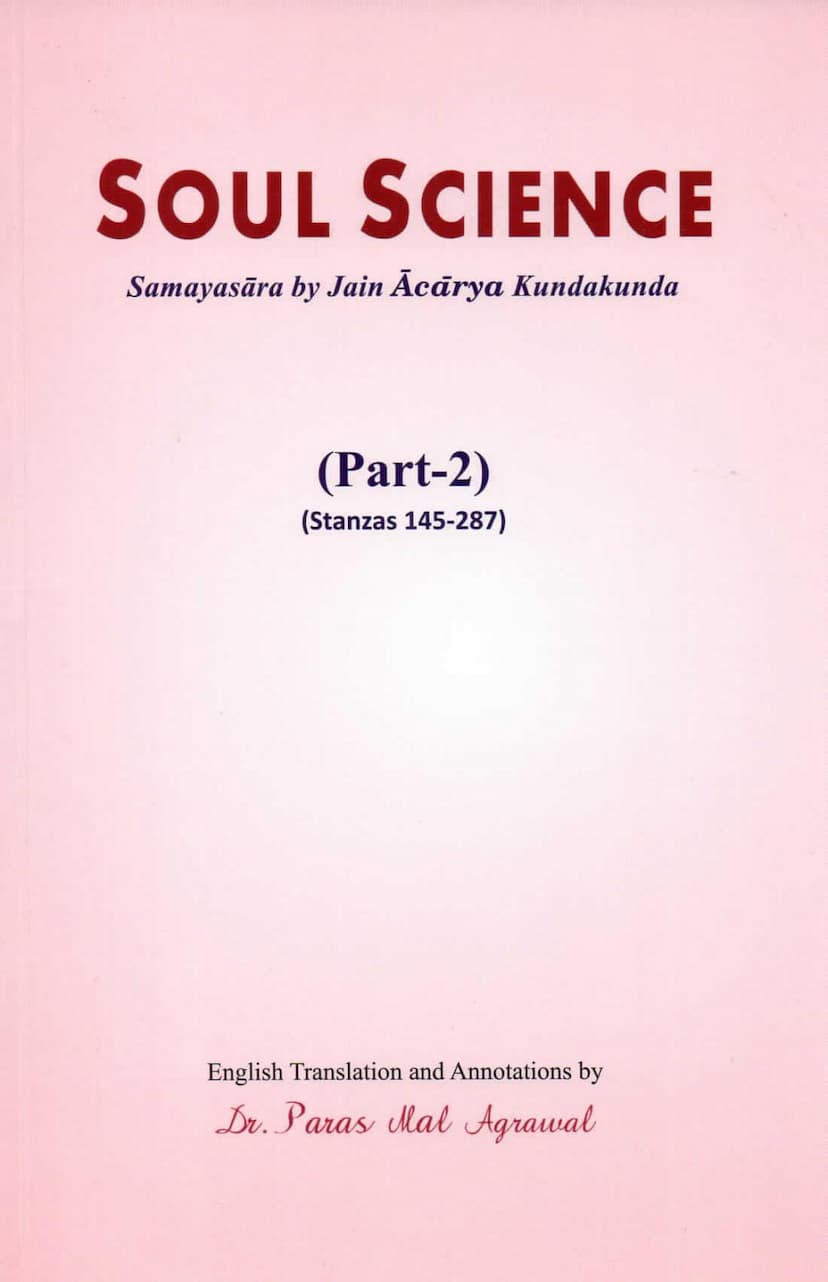Soul Science Part 02
Added to library: September 2, 2025

Summary
This document is the second part of "Soul Science," an English translation and annotation of Acharya Kundakunda's "Samayasara" by Dr. Paras Mal Agrawal. It covers stanzas 145-287, building upon the first part (stanzas 1-144).
Core Message:
The central theme of "Samayasara" is to distinguish the eternal, unchanging soul (Jiva) from everything else (non-soul, Ajiva). The book emphasizes that true bliss, peace, and happiness are achieved by realizing one's "I-ness" solely with the soul, free from attachments to physical bodies, pleasures, pains, emotions, and karmas.
Key Concepts and Themes Covered in Part 2 (Stanzas 145-287):
- Virtue and Vice (Punya and Papa): The text argues that both virtuous (auspicious) and non-virtuous (inauspicious) actions bind the soul. While commonly considered good and bad respectively, the scripture asserts that both lead to suffering and cycles of birth and death. The real conduct (Samyak Caritra) is described as realizing the Self and abiding in the Self, which involves detachment from all karmas.
- Influx of Karma (Asrava): This section details the causes of karmic bondage, including wrong belief (Mithyātva), vowlessness (Avirati), soul-soiling passions (Kaṣāya - anger, ego, deceit, greed), and Yoga (mental, vocal, and physical activities). It distinguishes between soul distortions (Sajñā) and matter distortions (Asajñā) in karma. An enlightened being (SamyagDrști) is characterized by the absence of these causes, leading to blocked influx and no new bondage, even if old karma fructifies.
- Stoppage of Influx of Karma (Samvara): Samvara is achieved through the "science of separation" (Bheda Vijñāna), which is the realization of the soul's distinctness from non-soul elements like emotions, karma, and the physical body. An enlightened being (Jñānī) understands that their true nature (Upayoga) is separate from anger, passions, and karma. This realization, coupled with detachment, prevents new karmic bonding.
- Shedding of Karma (Nirjarā): This chapter explains that even experiencing the results of past karma without attachment, ownership, or doership leads to shedding of karma. Analogies like gold in fire or a doctor using poison illustrate how an enlightened being can experience worldly interactions without being karmically bonded. The key is non-attachment and realizing that the soul is merely a knower (Jñānī), not the doer or owner of external experiences or emotions. Attributes like fearlessness, absence of desire, non-abhorrence, steadfastness, affection for the spiritual path, and propagation of virtuous teachings are highlighted as characteristics of an enlightened being.
- Bonding of Karma (Bandha): The text clarifies that karmic bondage primarily arises from "Adhyavasāna" – erroneous thoughts, beliefs, and dispositions, especially the false identification of the Self with the body, mind, or external actions. Analogies of oiled body collecting dust versus an unoiled body not collecting dust illustrate how attachment and wrong beliefs cause karmic bondage. Even virtuous acts, if motivated by ego or a desire for worldly gain, lead to bondage. The ultimate cause of bondage is the mistaken belief of being the doer and owner of actions and their consequences. The concept of "Nimitta" (instrumental cause) is discussed in relation to "Upādāna" (the inherent nature of the soul), emphasizing that while external factors (Nimitta) might trigger experiences, the soul's inherent nature and response (Upādāna) determine whether new karma is bonded.
- The Essence of Right Conduct: The right conduct of the soul is to abide in the soul itself, realizing its eternal, pure, and unchanging nature. This involves detaching from all worldly possessions and activities, focusing solely on the soul's knowledge attribute, and remaining content and satisfied within the soul.
Author's Approach:
Dr. Agrawal, a physicist by training, brings a scientific and logical approach to explaining these profound Jain philosophical concepts. He uses modern and scientific examples, analogies from everyday life, and clear reasoning to make the teachings of Acharya Kundakunda accessible to a contemporary audience. He emphasizes the importance of differentiating between the real (Nishcaya Naya) and relative (Vyavahara Naya) perspectives.
Significance of Acharya Kundakunda:
The book highlights the immense reverence for Acharya Kundakunda in the Digambar Jain tradition, reciting his name alongside Lord Mahavira and Gautam Ganadhara before any auspicious work. "Samayasara" is considered his most significant work.
Overall Purpose:
The book aims to provide readers with a deeper understanding of Jain soul science, leading to spiritual enlightenment, peace, happiness, and ultimately, liberation from the cycle of birth and death by realizing the true nature of the soul. It also draws parallels with contemporary motivational speakers and authors, suggesting the timeless relevance of these ancient teachings.